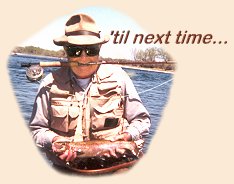
| ||
|
July 11th, 2005
|
|
Q. I live in southern Utah, and last year regularly fished a small (tiny) high mountain stream (I think it's elevation is over 9000 feet) that has what I presume to be wild Brook Trout since it isn't stocked. There is no lake that feeds it. As far as I can tell the water comes from run-off only. The stream in normal years varies from a couple feet wide to maybe 10 feet at its widest point. It is for the most part less than a couple of feet deep and in some of the "wide" points less than a foot. There are also occasional "pools." But again these are probably no more than a few feet deep and five or six feet across. About the only thing that signifies that it is a "pool" is the speed (or lack there of) of the current running through it. By the way, a "big" fish here is 10" or so. This past winter has been a banner year for snow fall, and this stream has been under a lot of snow (over ten feet) for a very long time. I checked it a few days ago, and it is finally clear and accessible, and flowing quite a bit higher than I've ever seen it. My questions are:
2. How "deep" and or "big" do pools need to be to allow fish to survive through a winter, or is it simply a function of the water not freezing? 3. I know that snow is actually a pretty good insulator. So does a stream like this continue to flow through the winter beneath the snow pack? Or is it more likely that it was nothing more than ice? Thanks, David Shumway
2. As I said above, as long as the pool is large enough to have free water that is adequately oxygenated, the fish will survive; surface ice is rarely a problem in streams. The fish do need some food, although metabolic functions are at low ebb when the water is near freezing. There are a couple of conditions that are detrimental to the fish. You mention one of them and that is when the water freezes solidly; obviously, this will kill the trout but is fairly rare where adequate flows prevail. The other condition occurs when the water reaches super cooled conditions (clear, cold nights) while it is still flowing and the surface is unfrozen. At this time, ice crystals (called "frazil ice") occur as slush in the water, or ice forms on the bottom (called "anchor ice"). Anchor ice forms initially in riffles, but can spread to larger areas if low temperatures prevail. Break-up of anchor ice scours the bottom, resulting in a loss of immature insects, abrasion of the periphyton community, and, in some cases, transport of embedded stones and gravel. 3. This one is harder to answer because it could vary with several things, especially the severity of the winter and adequacy of the water supply. Given that there is adequate flow throughout the winter, the chances of the stream freezing solidly beneath the snow pack probably depends on how cold the air temperatures are and how long they last. Prolonged sub-zero temperatures are more likely to result in a greater portion of the water freezing; conversely, warmer air temperatures will probably allow the water to remain flowing. Also, as you imply, the thickness of the snow pack may affect how much of the water column freezes. ~ Bert
~ C. E. (Bert) Cushing, aka Streamdoctor 105 W. Cherokee Dr. Estes Park, CO 80517 Phone: 970-577-1584 Email: streamdoctor@aol.com
|
| If you would like to comment on this or any other article please feel free to post your views on the FAOL Bulletin Board! |
[ HOME ]
[ Search ] [ Contact FAOL ] [ Media Kit ]
 The 'Stream Doctor' is a retired professional stream ecologist and
author, now living in the West and spending way too much time
fly-fishing. You are invited to submit questions relating to
anything stream related directly to him for use in this Q & A Feature
at
The 'Stream Doctor' is a retired professional stream ecologist and
author, now living in the West and spending way too much time
fly-fishing. You are invited to submit questions relating to
anything stream related directly to him for use in this Q & A Feature
at